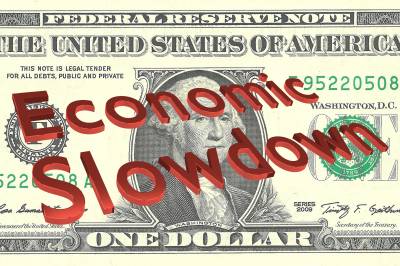
Whether you obtain your news from TV, newspapers or social media, it is hard to escape the drumbeat of downbeat updates about the North American and global economies. The negative news is puzzling to those people who monitor some of the leading, and still positive, economic indicators.
As noted in a recent paper by Jim Allworth, Co-Chair of the RBC Global Portfolio Committee, 5 of the 6 most commonly tracked economic indices on the bank’s Recession Scorecard are still positive. These include:
Unemployment claims
Unemployment rate
Conference board leading index
ISM new orders minus inventories
Fed Funds versus Nominal GDP growth
Jim reports that “the indicator that has ‘flipped’ to the negative is the so-called ‘shape of the yield curve,’ much discussed in the financial press. Simply put, the gap between short-term interest rates and long-term yields, normally comfortably wide in favour of the latter, has flip-flopped with short-term T-Bill rates now higher than the 10-year Treasury Note yield. This ‘inversion’ has almost always been a harbinger of a recession arriving a year or so down the road.”
Looking at the positive indicators, things are tightening up. Job growth in goods-producing industries, which White House officials used as a proxy for blue-collar jobs, has dropped to just 1 percent. Growth in core capital goods orders, a leading indicator of capital spending, has flatlined. A key measure of business capital spending in the United States, “fixed nonresidential investment,” was in negative territory in the second quarter.
The Institute for Supply Management’s Purchasing Managers’ Index, a closely watched measure of manufacturing health, has fallen to just above recession levels. The July reading was the weakest since August 2016. In the nation’s factories, the rate of growth has slowed for five consecutive months, according to the ISM’s index.
With only one of the six indicators listed above moving into negative territory, one might be led to conclude that the odds of a recession are still remote. The fact is that beyond these indices, several factors continue to weigh on the markets this week, prompting further volatility.
These include significant uncertainty surrounding international issues, including mounting evidence of slowing global growth, unresolved policy issues including Brexit, deteriorating trade relations and more recently, policy protests in Hong Kong. The flight-to-quality trade continues with investors fleeing equities and jumping into bonds or other relatively safe assets. As a result of international uncertainty and concerns of a global slowdown, global yields have retreated markedly in a short period of time – many into negative territory.
In addition, consumer and small business optimism have fallen. Blue-collar job growth has dropped to its lowest level since Mr. Trump took office. Economic growth, which Mr. Trump once promised would soar as high as 5 or 6 percent annually, is now running at about a 2 percent annualized pace. So, what could cause a recession?
As reported by Neil Irwin in the New York Times, “President Trump’s on-again-off-again execution of the trade war with China and other countries has fed uncertainty into businesses’ decision-making. Corporate investment spending is softening, despite the big tax cut that Mr. Trump said would boost it. And the combination of central banks that are at the outer limits of their ability to stimulate growth, and an inward turn by many countries, could make governments less effective at responding to a downturn. There are parallels to the past.
Often, a recession results when some widely held belief about the world turns out to be false. In 2001, it was that a technology boom would fuel the economy and the stock market indefinitely; in 2007, it was that the housing market would never melt down across all regions at once.”
This time around, the belief in doubt is that the world will only become more stable and interconnected over time, and that trade, currency and diplomatic relationships can be counted upon. This is questionable since “the economies in China and many of its Asian neighbors are getting weaker, partly as a result of the trade war with the United States. The European economy, which has muddled along for years with low growth, may be tumbling into a recession, and if Britain crashes out of the European Union with no exit deal on Oct. 31, Europe could face still deeper challenges.”
Mr. Irwin states that “recessions result not just when something bad happens in the economy; bad things happen all the time. Recessions occur when those initial shocks are multiplied, in ways that reverberate worldwide. The dot-com crash was accentuated by the Sept. 11 terrorist attacks in 2001 and a rash of corporate scandals. The 2007 housing bust in the United States became a global financial crisis in 2008 only because banks worldwide took huge losses on mortgage debt.”
Two in five economists surveyed by the National Association of Business Economists now expect the economy to slip into recession this year or next. What could tip the scales?
According to Mr. Irwin, “the trade wars and a breakdown in international economic diplomacy cause businesses around the world to pull back. This leads to further tumbles in markets and job losses, prompting American consumers to become more cautious. High corporate debt loads create a wave of bankruptcies. And central bank policy proves impotent, combined with fiscal policy that is nonexistent.”
While most of the “Recession Scorecard” indicators are still positive, even the stronger ones appear to be moving in the wrong direction. Get ready for a turbulent ride in 2020.
To stay up to date on Best Practices in Freight Management, follow me on Twitter @DanGoodwill, join the Freight Management Best Practices group on LinkedIn and subscribe to Dan’s Transportation Newspaper (http://paper.li/DanGoodwill/1342211466).



















